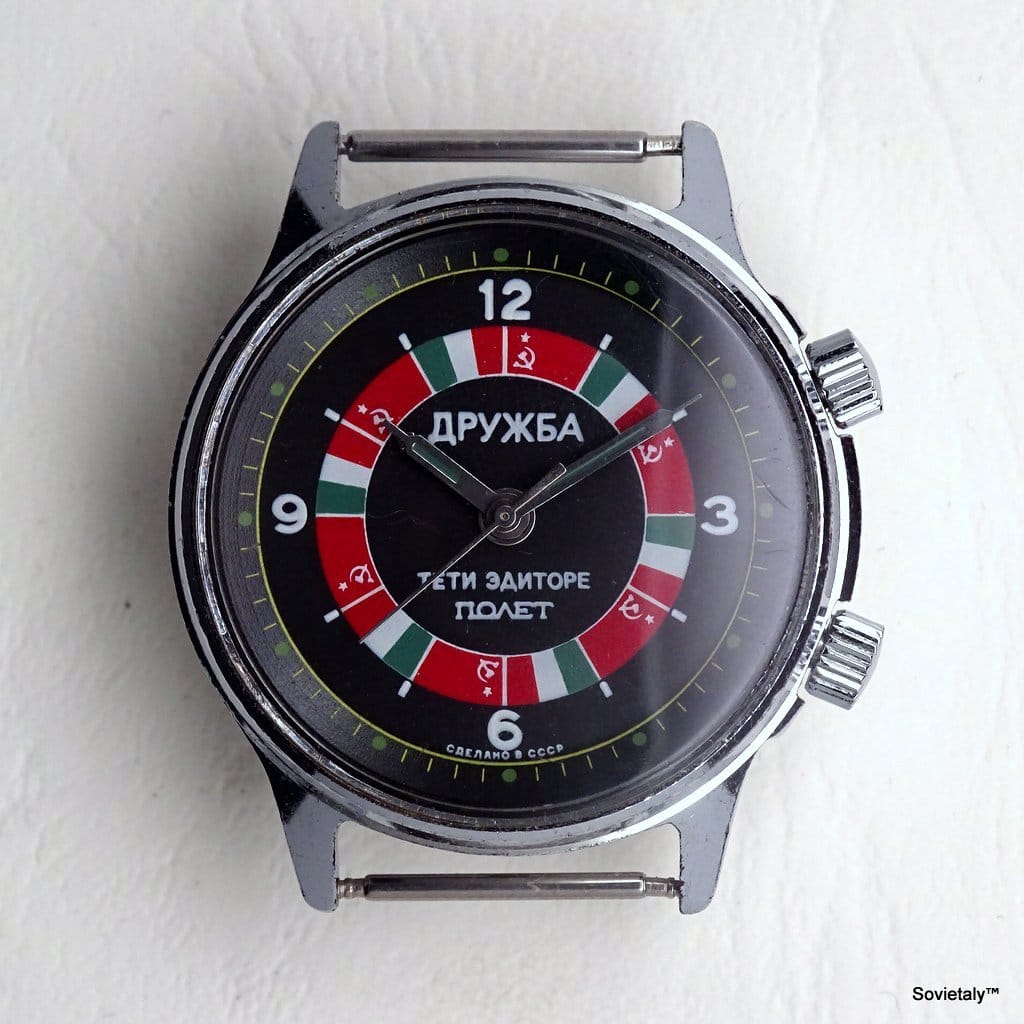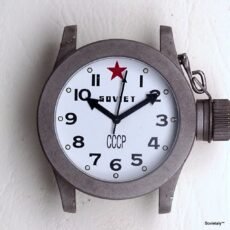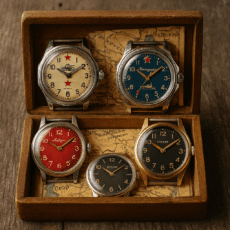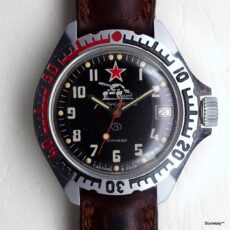In November 1989, during the historic state visit to Italy by Soviet leader Mikhail Gorbachev, an unusual symbol of friendship between the USSR and Italy was born: a wristwatch called Drusba. The name is the transliteration of the Russian word Дружба, which means “friendship” – perfectly reflecting the spirit of this initiative. The Drusba is an elegant unisex mechanical watch, produced in the Soviet Union by Poljot, and released in limited edition on behalf of Milan-based publisher Teti Editore. It was conceived both as a commemorative souvenir of Gorbachev’s visit and, above all, as an exclusive reward for readers of Il Calendario del Popolo, a historic Italian cultural magazine founded by the PCI (Italian Communist Party) after WWII.
A special offer by Il Calendario del Popolo (1989)
By the late 1980s, Il Calendario del Popolo – one of Italy’s longest-running cultural magazines, founded in 1945 – had begun focusing heavily on the Soviet Union and the climate of dialogue initiated by perestroika. In 1989, to boost subscriptions, Nicola Teti Editore launched an original promotional campaign: the Soviet watch Drusba was offered for free to anyone who signed up five new annual subscribers.
The promotion appeared in issues 524, 525, 526, and 527 of the magazine (from August to December 1989), emphasising the special bond between Italy and the USSR. In the August-September double issue, even a prototype of the watch dial was shown, indicating that design work began in early 1989. The offer culminated in issue no. 526 (November 1989), where the back cover proudly proclaimed: “Here is DRUSBA, the souvenir watch of Gorbachev’s visit to Italy… The Drusba watch is not for sale but will be given exclusively as a gift to those who secure five subscriptions to Il Calendario del Popolo (each subscription worth 30,000 lire).”
In practical terms, anyone who collected five subscriptions (for a total of 150,000 lire) received this prestigious commemorative timepiece. The promotional materials highlighted the Drusba’s quality features: “shock-resistant stainless steel round case, 18 jewels, four hands, alarm duration 10 seconds.”
At the time, the Drusba was positioned as a mid-to-high-end Soviet watch, with an estimated retail value between 100,000 and 400,000 lire – far from a budget item. It was made in limited edition, specifically for calendaristi, the loyal promoters of the magazine. Importantly, the Drusba was never sold commercially; it could only be obtained through this subscription campaign, as reiterated again in the December 1989 issue. This makes the Drusba today an exceptionally rare and sought-after piece, especially outside Russia.

A symbolic design and two known variants
The Poljot Drusba’s dial design conveys its message of friendship clearly. The silver-toned face features the Cyrillic word “Дружба” at the top and “Teti Editore” below it, both written in Cyrillic. Surrounding the dial, instead of standard hour markers, are twelve alternating Italian and Soviet flags – visually reinforcing the spirit of Italian-Soviet solidarity.
The overall aesthetic is tasteful and restrained. The watch has four hands (hours, minutes, central seconds, and a fourth hand for the alarm), housed under a domed plexiglass crystal. The case measures 36 mm, is chromed (promoted as “stainless steel” in contemporary advertising), and has two crowns: the main one at 4 o’clock for winding and setting the time, and a second one at 2 o’clock to wind and set the mechanical alarm.
Two variants of the Drusba are known, distinguishable by small details on the dial and crown:
- Variant A: The word “Poljot” (Latin or Cyrillic) appears below the Teti Editore logo, with right-angled crowns.
- Variant B: The word “Poljot” is above the logo, with pointed-end crowns.
These minor differences likely reflect separate production batches or last-minute design adjustments. Both variants feature the engraved caseback inscription “Сделано в СССР” (Made in USSR).
Alarm movement and technical details
Mechanically, the Drusba is a manual wind mechanical watch with an integrated alarm function – known as a svegliarino in Italian horological slang. It is powered by the Poljot 2612.1 calibre, a 17/18-jewel movement derived from the Swiss AS 1475.
This movement beats at 18,000 A/h and integrates a mechanical alarm lasting about 10–12 seconds. Winding the upper crown at 2 o’clock charges the alarm spring, while pulling and rotating the same crown sets the desired alarm time. At the preset time, a tiny internal hammer strikes a metal tab to produce a buzzing sound. In addition to the alarm, the watch displays hours, minutes, and continuous seconds.
Main technical specs:
- Movement: Poljot 2612.1 (18 jewels, AS 1475 derivative, mechanical alarm)
- Case diameter: 36 mm (chromed brass, steel caseback)
- Hands: 4 (hours, minutes, central seconds, alarm)
- Crowns: 2 (4 o’clock for time, 2 o’clock for alarm)
- Year of production: 1989 (limited edition for Teti Editore)
Each original Drusba was delivered in a Poljot-branded leather presentation box also marked by Teti Editore. This original packaging, featuring dual branding, is now exceptionally rare and adds significantly to the piece’s collectable value.
“Il Calendario del Popolo” and Teti Editore
The Drusba operation is deeply tied to the legacy of Il Calendario del Popolo and its publisher. Founded in 1945 in Rome under the auspices of the Italian Communist Party, the magazine aimed to spread cultural literacy and historical awareness in a newly-liberated Italy.
Over the decades, it became a prominent outlet for history, science, arts, and social commentary. In 1964, the publication was taken over by Nicola Teti Editore of Milan, who rescued the magazine financially and relaunched it. Teti published Il Calendario del Popolo without interruption for the next 46 years, bringing the magazine to its 75th anniversary in 2020.
Under the leadership of Nicola Teti (later joined by historian Franco Della Peruta), the magazine preserved its encyclopaedic and inclusive approach, often focusing on socialist countries and Soviet cultural output. The Drusba campaign fits naturally into this editorial tradition: a watch that symbolised political ideals and cross-cultural dialogue.
The 1989 campaign was enthusiastically received. The readers who acted as subscription promoters (calendaristi) took pride in wearing the Drusba, with its tricolour flags and the word “friendship”. For many, it was a wearable token of peace and solidarity during the final months of the Cold War. Just two years later, the USSR would collapse. But Il Calendario del Popolo continued its cultural mission into the 21st century, now published quarterly under the direction of Nicola Teti’s son, Sandro Teti.
A rare and meaningful collector’s piece
Today, the Poljot Drusba remains a fascinating historical object – equally compelling to Soviet watch collectors and enthusiasts of political publishing history. As it was never offered to the general market, finding an original in excellent condition is difficult. The appearance of a few NOS (New Old Stock) units, complete with original box, has reignited collector interest.
One such authentic piece is currently available in our online catalogue, offering the chance to own not just a vintage watch, but a true memento of Italian-Soviet friendship.



